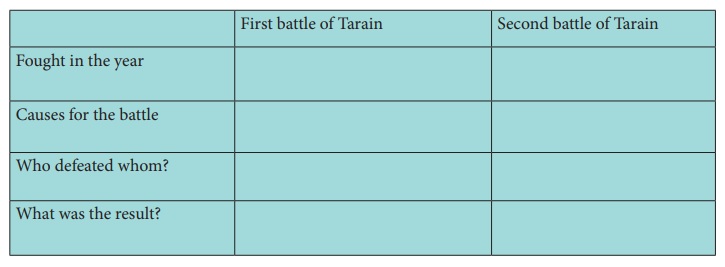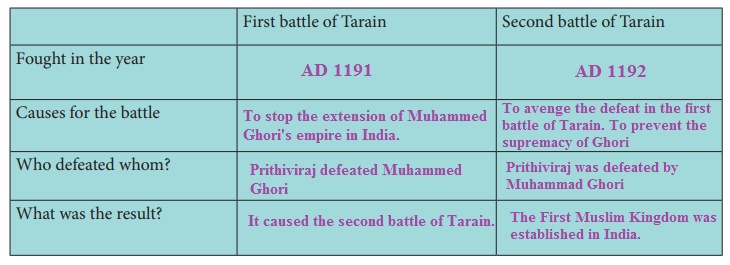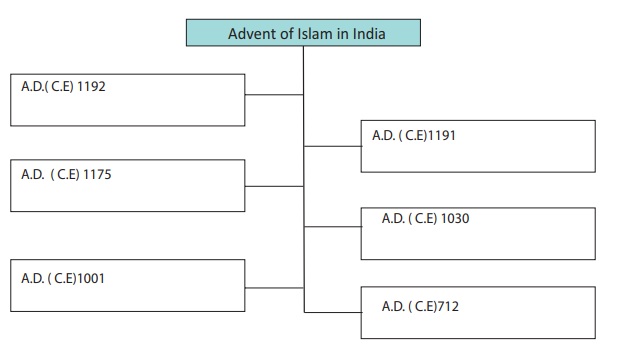Emergence of New Kingdoms in North India | Term 1 Unit 2 | History | 7th Social Science - Exercises Questions with Answers | 7th Social Science : History : Term 1 Unit 2 : Emergence of New Kingdoms in North India
Chapter: 7th Social Science : History : Term 1 Unit 2 : Emergence of New Kingdoms in North India
Exercises Questions with Answers
Evaluation
I. Choose
the correct answer
1. Who wrote Prithivirajraso?
a. Kalhana
b.
Vishakadatta
c. Rajasekara
d. Chand
Bardai
Answer: d. Chand Bardai
2. Who was the first prominent ruler of
Pratiharas?
a. Bhoja I
b. Naga
Bhatta I
c. Jayapala
d.
Chandradeva
Answer: b. Naga Bhatta I
3. Ghazni was a small principality in
_______
a. Mangolia
b. Turkey
c. Persia
d.
Afghanistan
Answer: d. Afghanistan
4. What was the most important cause of
the invasion of Mahmud of Ghazni?
a. To destroy
idolatry
b. To plunder
the wealth of India
c. To spread
Islam in India
d. To
establish a Muslim state in India
Answer: b. To plunder the wealth of India
II.
Fill in the blanks
1. Dharmapala was the founder of Vikramashila University.
2. Arabs
conquered Sind in AD 712.
3. The city
of Ajmeer was founded by Simharaji.
4. The
Khandarya temple is in Madhya Pradesh.
III. Match
the following
A B
1. Khajuraho Mount Abu
2. Sun temple Bundelkhand
3. Dilwara Temple Konark
Answer: 1) Bundelkhand 2) Konark
3) Mount Abu
1. Khajuraho : Bundelkhand
2. Sun temple : Konark
3. Dilwara Temple : Mount
Abu
IV. True or False
1. Rajputra is a Latin word. - False
Rajputra is a Sanskrit word.
2. King Gopala was elected by the
people. - True
3. The temple at Mount Abu is dedicated
to Lord Shiva. – False
The temple at Mount Abu is dedicated to Jain Tirthankaras
4. Raksha Bandan is a festival of
brotherhood. - True
5. Indians learnt the numerals 0 – 9
from Arabs. – False
Arabians learnt the numerals
0-9 from Indians.
V Consider
the following statements. Tick ( √ ) the appropriate answer.
1.
Assertion:- The
tripartite struggle was to have control over Kanauj.
Reason:- Kanauj was a big city.
a. R is the correct explanation of A.
b. R is not the correct explanation of
A.
c. A is wrong and R is correct.
d. A and R are wrong.
Answer: b. R is not the correct
explanation of A.
2.
Statement I. Mahipala
could not extend his domain beyond Benaras.
Statement
II. Mahipala and Rajendra Chola were
contemporaries.
a. I is correct.
b. II is correct.
c. I and II are correct.
d. I and II are false.
Answer: c. I and II
are correct
3.
Assertion:- India’s
Islamic period did not begin after Arab conquest of Sind in AD (CE)712.
Reason:-
Gurjara Pratiharas gave a stiff
resistance to Arabs.
a. R is the correct explanation of A.
b. R is not the correct explanation of
A.
c. A is correct and R is wrong.
d. A is wrong and R is correct.
Answer: a. R is the correct
explanation of A.
4.
Assertion:- The second
battle of Tarain was lost by Prithiviraj.
Reason:-There was disunity among the Rajputs
a. R is the correct explanation of A.
b. R is not the correct explanation of
A.
c. A is correct and R is wrong.
d. A is wrong and R is correct.
Answer: c. A is correct and R is
wrong.
5.
Consider the following statements and find out which is/are correct.
1. Raksha Bandan tradition is
attributed to Rajputs.
2. Tagore started a mass Raksha Bandan
festival during Partition of Bengal
3. Raksha Bandan was to counter the
British attempt to create a divide between Hindus and Muslims.
a. 1 is correct.
b. 2 is correct.
c. 3 is correct.
d. All the above are correct.
Answer: d. All the above are
correct.
VI. Answer in one or two
sentences
1.
Write about tripartite struggle over Kanauj.
There was a prolonged tripartite
struggle between the Gurjara Pratiharas of Malwa, The Rashtrakutas of Deccan
and the Palas of Bengal, as each one of them wanted to establish their
supremacy over the fertile region of Kanauj. In the process, all the three
powers were weakened.
2.
Name any four Rajput clans.
The Pratiharas, the Chauhans, the
Chalukyas (different from the Deccan Chalukyas), known as Solankis, and the
Paramaras of Pawars were the four Rajput clans. All the four clans were of the
Agnikula origin.
3.
Who was the founder of Pala dynasty?
Gopala was the founder of Pala
dynasty.
4. Mention the first two early
Caliphates.
Two early Caliphates were 'Umayyads' and the 'Abbasids.
5.
Name the ruler of Sind who was defeated by Qasim.
Dahir
VII. Answer the following
1.
What was the impact of Arab conquest of Sind? (point out any five)
The Arab scholars visited Sind and
studied many Indian literary works. They translated many Sanskrit books on
astronomy, philosophy, mathematics and medicine into Arabic. They learnt the
numerals 0 to 9 from India. Until then, the people in the West did not know the
use of zero. Through the Arabs, Europe gained more knowledge in mathematics.
The importance of zero was learnt by them from India. It is believed that the
people in the West and the Arabs learnt the game of chess only from the
Indians.
VIII. HOTs
a. Difference between Mahmud Ghazni’s invasion and Muhammad Ghor’s invasion.

Mahmud Ghazni's
invasion
• Aimed at plundering the rich temples and cities of North India.
• Many cities were plundered and taken to the Capital Ghazni.
Muhammad Ghazni's
invasion
• Extension of his empire by conquering India.
• It led way to the establishment of the first Muslim Empire.
b. Find out


IX. Students activity
a. Word Splash
(Students
discuss what they know about the words given here. They use the words from what
they have learnt in a narrative form)
Harsha Rajputs
Kanauj
VikramashilaPrithivirajCaliph
b. Time Line
Write
the event for the given year in each column.

Advent of Islam in India
A.D.(C.E) 1192 The
Second battle of Tarain ensued
A.D.(C.E) 1191 The
First battle of Tarain ensued
A.D (C.E) 1175
Muhammed Ghori Captured Multan
A.D.(C.E) 1030
Mahmed Ghazni died
A.D. (C.E) 1001
Shahi Kingdom was defeated by Mahmud of Ghazni
A.D.(C.E) 712 Arab
conquest of Sind
X. Map work
On the river map of India mark the
territories ruled by Pratiharas, Chauhans, Palas and Paramaras.

XI. Answer Grid
1.
Who was the Shahi ruler of Punjab defeated by Mahmud of Ghazni? Ans: Jeyapala
2. Rajput style of Painting is called
_________ Ans: Rajasthani
3. How many Rajput clans were there? Ans: Thirty six
4. Who established the first Islamic
empire in India? Ans: Muhammed of Ghor
5. Who was the first Sultan of Delhi? Ans: Qutb-ud-din Aibak
6. Where is Mecca? Ans: Arabia
XII. Life skill
Make an album with the pictures of
temples built by Rajput rulers.
Related Topics